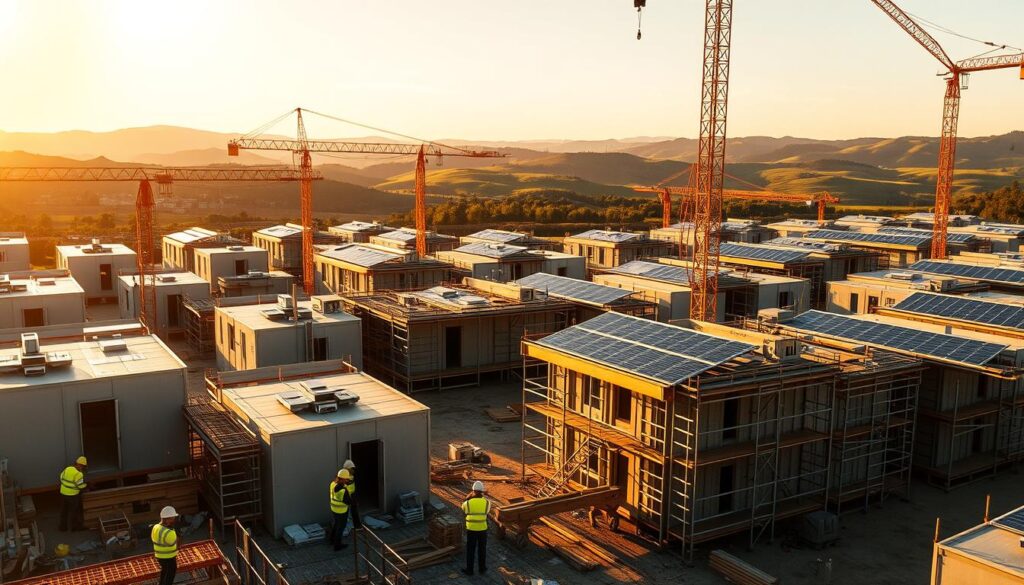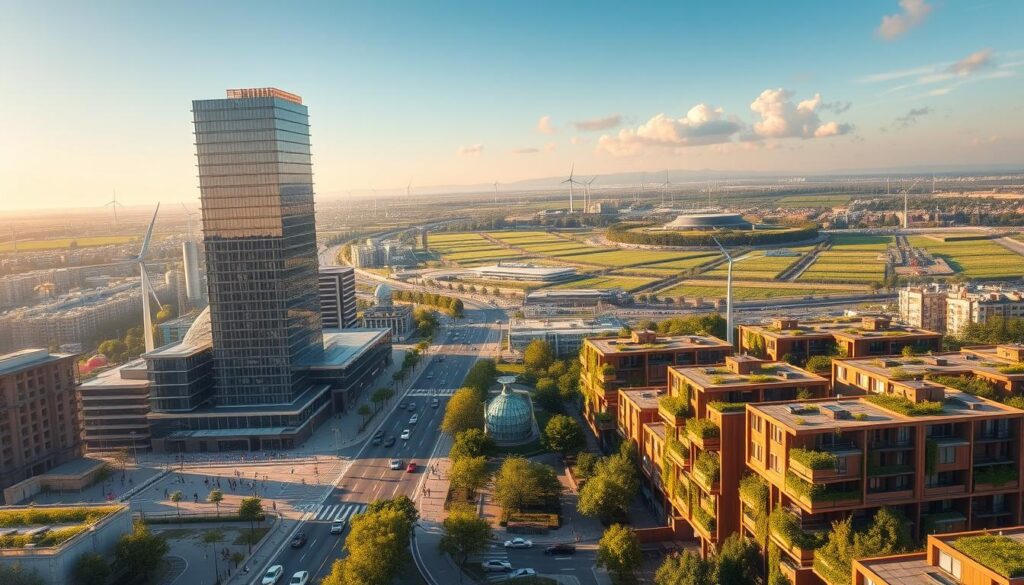The construction industry is a significant contributor to global emissions, with the sector accounting for a substantial portion of the world’s carbon footprint. As the world strives for net-zero emissions, engineering and construction companies are under increasing pressure to adopt sustainable construction practices.
Studies have shown that the global population is utilizing resources beyond the Earth’s capacity, with over 80% of the population living in ecological deficits. The construction industry plays a crucial role in all three aspects of sustainability: economic, environmental, and social. According to recent research published in a study on sustainability in project management, there has been a significant increase in publications on this topic since 2017, highlighting the growing importance of sustainable practices in the industry sustainable project management.
Key Takeaways
- The construction industry must adopt sustainable practices to reduce its carbon footprint.
- Global emissions from construction are significant, contributing to ecological deficits.
- Sustainable construction practices are crucial for achieving net-zero emissions.
- The industry’s economic, environmental, and social sustainability are interconnected.
- Research on sustainability in project management has seen a significant surge since 2017.
Introduction to Sustainable Engineering
As the world grapples with environmental challenges, sustainable engineering emerges as a critical discipline. It involves designing and constructing projects that minimize environmental impact while promoting economic and social benefits. Sustainable engineering is not just a trend; it’s a necessity for the future of our planet.
Definition of Sustainable Engineering
Sustainable engineering is defined as the practice of designing and constructing systems that are environmentally friendly, socially just, and economically viable. It integrates global engineering standards and sustainable design principles to achieve projects that are beneficial for both the environment and the community.
The core of sustainable engineering lies in its holistic approach, considering the entire lifecycle of a project from conception to completion, and even to its eventual decommissioning. This approach ensures that every phase of the project is optimized for minimal environmental impact.
Importance of Sustainability in Engineering
The importance of sustainability in engineering cannot be overstated. With the increasing global population and the consequent strain on natural resources, sustainable engineering practices are crucial for minimizing the ecological footprint of construction and engineering projects.
By adopting sustainable engineering practices, we can significantly reduce the environmental impact of our projects. This includes reducing greenhouse gas emissions, conserving water, and minimizing waste. The table below highlights some key sustainable engineering practices and their benefits.
| Sustainable Practice | Environmental Benefit | Economic Benefit |
|---|---|---|
| Using renewable energy sources | Reduces reliance on fossil fuels | Lowers energy costs over time |
| Implementing energy-efficient systems | Decreases greenhouse gas emissions | Reduces operational costs |
| Water conservation techniques | Conserves water resources | Lowers water bills |
In conclusion, sustainable engineering is a vital component of modern engineering practices. By understanding its definition and importance, we can better appreciate the need to adopt sustainable practices in our projects.
Global Trends in Sustainable Construction

Sustainable construction is gaining momentum worldwide, with a notable increase in green building certifications. This trend reflects a broader shift towards eco-friendly building solutions and sustainable architecture trends that prioritize environmental sustainability.
The construction industry is one of the largest consumers of natural resources and generators of waste. As such, the adoption of sustainable practices is crucial for reducing its environmental footprint. Sustainable construction practices are being increasingly adopted globally, driven by the need to minimize environmental impact.
Rise of Green Building Certification
Green building certification has emerged as a significant trend in sustainable construction. Certifications such as LEED (Leadership in Energy and Environmental Design) and BREEAM (Building Research Establishment Environmental Assessment Method) are recognized internationally for their rigorous standards in assessing building sustainability.
The rise in green building certification is driven by several factors, including:
- Increasing awareness of environmental issues
- Regulatory incentives
- Market demand for sustainable buildings
As of recent data, the number of green-certified buildings has seen a significant increase, reflecting a global commitment to sustainable development.
| Certification Type | Number of Buildings | Percentage Increase |
|---|---|---|
| LEED | 100,000+ | 20% |
| BREEAM | 50,000+ | 15% |
Emphasis on Renewable Resources
Another key trend in sustainable construction is the emphasis on renewable resources. The use of materials such as sustainably sourced timber, recycled materials, and low-carbon concrete is becoming more prevalent.
The benefits of using renewable resources include:
- Reduced dependence on non-renewable resources
- Lower carbon footprint
- Enhanced energy efficiency
The global construction industry is witnessing a significant shift towards sustainability, driven by the rise of green building certification and an emphasis on renewable resources. As the industry continues to evolve, it is likely that we will see even more innovative and sustainable construction practices emerge.
Major Sustainable Engineering Practices
Major sustainable engineering practices are transforming the way we build and maintain infrastructure. These practices not only reduce environmental impact but also offer long-term economic benefits.
Energy Efficiency Techniques
Energy efficiency is a critical component of sustainable engineering. Techniques such as using LED lighting, optimizing building insulation, and incorporating renewable energy sources like solar and wind power can significantly reduce energy consumption.
Moreover, the use of energy-efficient HVAC systems and smart building technologies can further enhance energy savings. These technologies enable real-time monitoring and control of energy usage, allowing for adjustments to be made as needed.
Water Conservation Methods
Water conservation is another vital aspect of sustainable engineering. Methods such as rainwater harvesting, greywater reuse, and implementing low-flow fixtures can significantly reduce water consumption.
Additionally, using water-efficient appliances and implementing drought-resistant landscaping can further contribute to water conservation efforts. These practices not only save water but also reduce the strain on municipal water supplies.
Waste Reduction Strategies
Waste reduction is a key element of sustainable engineering practices. Strategies such as recycling construction materials, minimizing packaging waste, and implementing waste-to-energy systems can significantly reduce the environmental impact of construction projects.
Furthermore, adopting prefabricated construction methods and using sustainable materials can also reduce waste. These approaches minimize on-site waste generation and promote the use of materials that are recyclable or have a lower environmental footprint.
By incorporating these major sustainable engineering practices, the construction industry can significantly reduce its environmental impact while promoting long-term sustainability.
Innovations in Sustainable Materials

The advent of biodegradable and recyclable materials is transforming the construction landscape, aligning with sustainable design principles. As the construction industry continues to evolve, the emphasis on sustainable materials has become more pronounced, driven by the need for green infrastructure development.
Biodegradable Materials
Biodegradable materials are gaining traction in the construction sector due to their potential to reduce environmental impact. These materials can decompose naturally, minimizing waste and the carbon footprint associated with traditional construction materials.
Some examples of biodegradable materials include:
- Plant-based composites
- Biodegradable plastics
- Recycled paper products
According to a report by the International Energy Agency, the use of biodegradable materials in construction can significantly reduce greenhouse gas emissions. “The shift towards biodegradable materials is a crucial step in achieving a more sustainable construction industry,” the report states.
Recyclable Construction Resources
Recyclable construction resources are another vital component of sustainable construction practices. Materials such as steel, glass, and certain plastics can be recycled, reducing the need for virgin resources and minimizing waste.
| Material | Recyclability | Environmental Benefit |
|---|---|---|
| Steel | High | Reduces energy consumption and conserves natural resources |
| Glass | High | Reduces waste and conserves raw materials |
| Plastics | Moderate | Reduces landfill waste and conserves non-renewable resources |
The use of recyclable materials not only supports sustainable design principles but also contributes to green infrastructure development by reducing the environmental footprint of construction projects.
“The future of construction lies in sustainable materials and practices. By embracing biodegradable and recyclable materials, we can significantly reduce our environmental impact.”
Case Studies: Successful International Projects
Sustainable engineering practices have been successfully implemented in various international projects, showcasing innovative solutions to global challenges. These projects not only demonstrate the feasibility of sustainable construction but also highlight the benefits of adopting eco-friendly practices on a large scale.
The Eden Project in the UK
The Eden Project, located in Cornwall, UK, is a large-scale environmental complex that has become a symbol of sustainable construction. This project features massive biomes that house plants from different climates around the world, showcasing sustainable engineering practices. The Eden Project has been recognized for its innovative use of sustainable materials and energy-efficient systems.
One of the key features of the Eden Project is its use of recycled materials in construction, including the reuse of china clay waste to create the site’s foundation. This approach not only reduced waste but also minimized the project’s environmental footprint. For more information on sustainable building materials, visit World Civil Society.
Bosco Verticale in Italy
Bosco Verticale, or the Vertical Forest, in Milan, Italy, is another exemplary model of sustainable engineering. This residential tower is covered in trees and plants, providing insulation and improving air quality. The project demonstrates how urban areas can be revitalized through sustainable construction practices.
| Project | Location | Sustainable Features |
|---|---|---|
| The Eden Project | UK | Recycled materials, energy-efficient systems |
| Bosco Verticale | Italy | Urban reforestation, improved insulation |
Both projects highlight the potential for international construction innovations to drive positive environmental change. By adopting sustainable practices, the construction industry can significantly reduce its environmental impact while creating healthier, more sustainable environments for communities worldwide.
Regulatory Framework for Sustainable Practices

A well-structured regulatory framework is essential for the adoption of sustainable practices in the engineering and construction sectors. This framework not only guides the implementation of sustainable design principles but also ensures compliance with global engineering standards.
The regulatory framework comprises various components, including international guidelines and national policies. These elements work together to promote sustainability and reduce environmental impact.
International Guidelines and Standards
International guidelines play a crucial role in standardizing sustainable practices across borders. Organizations such as the International Organization for Standardization (ISO) develop and publish global engineering standards that facilitate the adoption of sustainable technologies and methods. For instance, ISO 14001 is a widely recognized standard for environmental management systems.
These international guidelines provide a common language and framework for companies operating in multiple countries, ensuring consistency in their sustainability efforts. By adhering to these standards, businesses can enhance their credibility and demonstrate their commitment to sustainable practices.
National Policies Promoting Sustainability
National policies are vital for promoting sustainability within a country’s borders. Governments around the world are implementing various initiatives to encourage the use of sustainable design principles in construction and engineering projects. For example, countries like Germany and Sweden have introduced stringent building codes that prioritize energy efficiency and environmental sustainability.
These national policies often include incentives for businesses and individuals who adopt sustainable practices. By visiting resources like cutting construction costs in Africa, one can gain insights into how different regions are implementing cost-effective sustainable construction methods.
In conclusion, a robust regulatory framework that includes both international guidelines and national policies is crucial for advancing sustainable practices globally. By understanding and adhering to these frameworks, the engineering and construction sectors can make significant strides towards a more sustainable future.
Challenges Facing Sustainable Engineering
The journey towards sustainable engineering is not without its hurdles, including economic and technological barriers. As the world increasingly adopts environmental construction techniques, the industry must navigate these challenges to achieve long-term sustainability.
Economic Barriers to Adoption
One of the significant challenges facing sustainable engineering is the economic barrier to adoption. The initial investment required for sustainable technologies and materials can be prohibitively expensive, deterring companies and governments from adopting these practices. For instance, the cost of renewable energy technologies, although decreasing, can still be higher than traditional energy sources in some regions.
Moreover, the economic viability of sustainable projects is often questioned due to the lack of clear return on investment (ROI) analyses. This uncertainty can make it difficult for stakeholders to justify the upfront costs associated with sustainable engineering projects.
Technological Limitations
Besides economic barriers, technological limitations also pose a significant challenge to sustainable engineering. The development and implementation of best practices in sustainable engineering require advanced technologies that are not always available or are still in the nascent stages.
For example, energy storage technologies, crucial for the widespread adoption of renewable energy, are still evolving. The efficiency, cost, and scalability of these technologies need to improve significantly to support sustainable engineering practices fully.
Furthermore, the integration of sustainable technologies with existing infrastructure can be complex, requiring significant modifications or entirely new systems. This complexity can hinder the adoption of sustainable engineering practices.
In conclusion, while sustainable engineering is crucial for the future, it faces significant challenges that need to be addressed. By understanding and overcoming these economic and technological barriers, we can pave the way for more widespread adoption of sustainable practices.
The Role of Technology in Sustainability

The integration of technology in construction is paving the way for eco-friendly building solutions. As the world shifts towards more sustainable practices, technology plays a crucial role in enhancing the efficiency and reducing the environmental impact of engineering projects.
One of the key technological advancements in this field is Building Information Modeling (BIM). BIM allows for the creation of detailed digital representations of physical and functional characteristics of buildings. This not only improves the design and construction process but also enhances the operation and maintenance of buildings over their lifecycle.
Building Information Modeling (BIM)
BIM is revolutionizing the construction industry by enabling architects, engineers, and contractors to collaborate more effectively. It facilitates the simulation of various scenarios, allowing for the optimization of building performance and the reduction of potential errors. As sustainable architecture trends continue to evolve, BIM is becoming an indispensable tool for achieving sustainability goals.
The use of BIM has been praised by industry leaders for its potential to transform the construction sector. “BIM is not just a tool, it’s a process that changes the way we design, build, and operate buildings,” says a renowned architect.
Smart Building Technologies
Another significant technological advancement is the development of smart building technologies. These technologies integrate various building systems to optimize energy usage, improve occupant comfort, and enhance operational efficiency. Smart buildings utilize sensors, automation systems, and data analytics to create a more sustainable and responsive built environment.
The implementation of smart building technologies is a key factor in achieving eco-friendly building solutions. By leveraging real-time data and advanced analytics, buildings can adapt to changing conditions, reducing waste and improving overall performance.
As the construction industry continues to embrace these technologies, we can expect to see significant advancements in sustainable architecture trends. The future of sustainable engineering is closely tied to the development and integration of innovative technologies like BIM and smart building technologies.
Community Involvement in Sustainable Practices
Engaging communities is a vital step towards promoting sustainable practices and green infrastructure development. Community involvement is essential for the successful implementation of sustainable design principles, as it ensures that projects are tailored to the needs and values of the local population.
Engaging Local Stakeholders
Engaging local stakeholders is a critical component of community involvement. This can be achieved through various means, such as:
- Public meetings and forums
- Surveys and feedback mechanisms
- Collaborative planning processes
By involving local stakeholders in the decision-making process, projects can better address community needs and foster a sense of ownership.
Educating the Public
Educating the public about sustainable practices is another crucial aspect of community involvement. This can be done through:
- Workshops and training programs
- Public awareness campaigns
- Integration of sustainability into school curricula
By educating the public, communities can empower individuals to make informed decisions and adopt sustainable lifestyles.
In conclusion, community involvement is a cornerstone of sustainable development. By engaging local stakeholders and educating the public, communities can promote the adoption of sustainable design principles and contribute to a more sustainable future.
Economic Benefits of Sustainable Engineering

The economic advantages of adopting sustainable engineering practices are multifaceted and far-reaching. As the world shifts towards more environmentally friendly construction methods, the financial benefits become increasingly apparent.
One of the primary economic benefits is cost savings over time. Sustainable engineering often involves the use of energy-efficient systems and renewable resources, which can significantly reduce operational costs. According to a report by Deloitte, companies that invest in sustainable practices tend to see a return on investment through reduced energy and water consumption.
Cost Savings Over Time
Sustainable engineering practices lead to substantial cost savings by minimizing waste and optimizing resource use. For instance, the use of Building Information Modeling (BIM) allows for more accurate planning and reduced material waste, directly impacting the bottom line.
As notable civil engineering companies adopt sustainable practices, they not only contribute to environmental conservation but also benefit from long-term cost savings.
Job Creation in Green Industries
Another significant economic benefit of sustainable engineering is the creation of new job opportunities in green industries. As the demand for sustainable construction practices grows, so does the need for professionals skilled in these areas. This shift is expected to continue, with the green construction sector projected to drive employment growth in the coming years.
“The green building market is expected to continue its growth trajectory, driven by increasing demand for sustainable construction practices and green building certifications.”
By investing in sustainable engineering, companies can not only reduce their environmental footprint but also capitalize on the economic benefits, including cost savings and job creation in emerging green industries.
Future Outlook for Sustainable Engineering
The future outlook for sustainable engineering is bright, with innovations in eco-friendly building solutions leading the way. As the world continues to grapple with environmental challenges, the role of sustainable engineering in shaping a more resilient future cannot be overstated.
Emerging Trends and Predictions
Several emerging trends are expected to drive the future of sustainable engineering. These include:
- The increasing adoption of green building technologies, such as energy-efficient systems and renewable energy integration.
- The development of new sustainable materials that are not only eco-friendly but also offer enhanced performance and durability.
- The use of Building Information Modeling (BIM) to optimize building design and reduce waste.
As sustainable architecture trends continue to evolve, we can expect to see more buildings that are not only environmentally friendly but also serve as models for future construction projects.
Long-term Sustainability Goals
Achieving long-term sustainability goals will require a concerted effort from all stakeholders, including governments, industries, and individuals. Some key objectives include:
- Reducing carbon emissions through the adoption of renewable energy sources and energy-efficient practices.
- Promoting the use of eco-friendly building solutions that minimize environmental impact.
- Encouraging sustainable practices throughout the entire lifecycle of a building, from design to decommissioning.
As we move forward, it is clear that sustainable engineering will play a critical role in creating a more sustainable and resilient built environment. By embracing emerging trends and working towards long-term sustainability goals, we can create a brighter future for generations to come.
Collaborative Efforts in Sustainability

Sustainability in engineering is being advanced through global partnerships. These collaborations are crucial in driving the adoption of sustainable design principles and global engineering standards across borders.
Partnerships between governments and organizations play a pivotal role in promoting sustainability. These collaborations facilitate the sharing of knowledge, resources, and best practices, ultimately leading to more effective sustainability initiatives.
Partnerships Between Governments and Organizations
Governments and organizations are increasingly recognizing the importance of working together to achieve sustainability goals. Such partnerships enable the development of robust frameworks and policies that support sustainable practices.
- Development of international guidelines and standards
- Implementation of national policies promoting sustainability
- Collaboration on large-scale sustainable projects
International Forums and Conferences
International forums and conferences provide a platform for stakeholders to come together, share experiences, and discuss challenges. These events are instrumental in fostering global cooperation and advancing sustainability.
| Event | Focus Area | Outcome |
|---|---|---|
| Global Sustainability Forum | Renewable Energy | Increased adoption of solar and wind energy |
| International Green Building Conference | Sustainable Construction | Promotion of green building practices worldwide |
| World Sustainable Development Summit | Climate Change Mitigation | Enhanced global commitment to reducing carbon emissions |
By working together through partnerships and international events, the global community can accelerate progress toward a more sustainable future.
Best Practices for Engineers
Engineers can significantly contribute to sustainability by implementing best practices in their work. This involves a multifaceted approach that encompasses various aspects of engineering, from design to execution. By adopting sustainable practices, engineers can reduce the environmental footprint of their projects while enhancing their overall quality and efficiency.
Integrating Sustainability into Design
Integrating sustainability into design is a critical best practice for engineers. This involves using sustainable materials, optimizing energy efficiency, and minimizing waste. For instance, engineers can use RILEM’s resources on sustainable materials to inform their design choices. By considering the environmental impact of their designs, engineers can create structures that are not only functional but also environmentally friendly.
- Use of recycled and recyclable materials
- Design for energy efficiency
- Minimization of waste through efficient design
Continuing Education in Sustainability
Continuing education in sustainability is essential for engineers to stay updated on the latest best practices and technologies. This can involve participating in workshops, seminars, and online courses that focus on sustainable engineering practices. By enhancing their knowledge and skills, engineers can better address the challenges of sustainability in their work.
“The key to successful sustainable engineering lies in continuous learning and adaptation.” Engineers should prioritize ongoing education to remain at the forefront of sustainable practices.
By integrating sustainability into their designs and committing to ongoing education, engineers can play a pivotal role in shaping a more sustainable future. This not only benefits the environment but also contributes to the advancement of the engineering profession as a whole.
Conclusion: The Path Ahead for Sustainable Engineering
The path to sustainable engineering is complex and multifaceted, requiring a comprehensive approach that incorporates expert analysis and international cooperation. As highlighted in this article, sustainable construction practices are crucial in reducing the environmental impact of the construction industry.
Key Takeaways
The global production of materials such as cement and steel has significant environmental implications, contributing to CO2 emissions and resource depletion. Implementing sustainable engineering practices, such as energy efficiency techniques and waste reduction strategies, is essential in mitigating these effects.
Ongoing Commitment
As the world moves towards a more sustainable future, ongoing commitment to sustainable engineering practices is vital. This requires continued innovation, investment in green technologies, and collaboration between governments, organizations, and local communities. By working together, we can reduce the environmental footprint of the construction industry and create a more sustainable built environment, aligning with the principles of Expert Analysis on Sustainable Engineering and Construction Practices Internationally.
